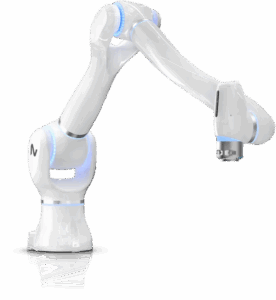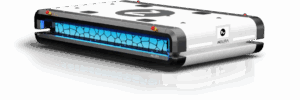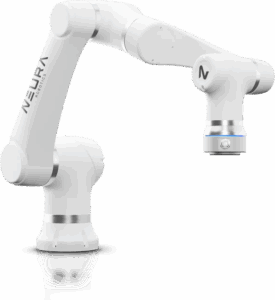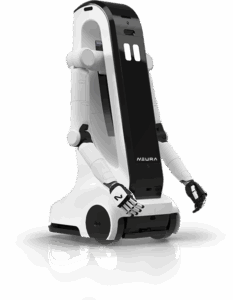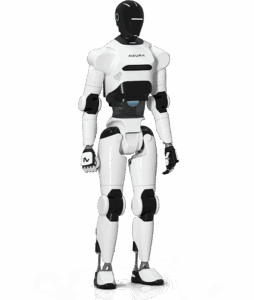We are creating a new kind of robot – based on cognitive Neura-technology.
A robot that supports any kind of task, a robot created for all areas of life.
By David Reger, CEO and Founder of NEURA Robotics
The future of humanity
Imagine: the year is 2030, and technology is the driving force that has helped our society advance toward self-determination, transparency, unlimited mobility, and universal healthcare.
Robots do dull, dirty, or dangerous work for us. Thanks to legislative reform, these intelligent machines are now fairly contributing to social systems by enabling free healthcare and the best possible education for all. Humans are free to shape their professional and personal lives without restrictions, according to their interests and abilities.
Technological progress has always been tied to uncertainty and doubt. In many people’s eyes, technology ultimately only takes away jobs. These suspicions towards technological advancement have existed since the first industrial revolution, and we have carried them with us throughout centuries of progressing automation.
In reality, robots have helped us achieve such efficiency, precision, and scalability otherwise impossible with human labor alone. Thanks to robotics, humanity has seen an increase in prosperity, and society is constantly moving forward.
In the last decade, many so-called collaborative robots have been developed to assist workers and perform repetitive tasks. Unfortunately, most cobots today cannot work shoulder-to-shoulder with humans: their lack of human-like consciousness means they do not perceive humans in a way that allows safe interaction between them.
Serving people
I founded Neura Robotics to develop intelligent robots that can fill that gap, working closely with humans in a danger-free environment, anywhere, anytime. Our guiding principle, we serve humanity, describes our ambition to leave a positive mark on a wide range of professions by making them more enticing, social, and safer. In my opinion, we should consider robots as reliable service providers for us humans!
We are on the threshold of a new era, in which intelligent robots are the key to drastically improving everyone’s quality of life.
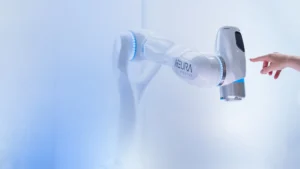
With MAiRA, we have introduced the first ever commercially available cognitive robot. Its integrated AI and unique sensor technologies enable it to interact safely and naturally with humans.
Despite this, the question arising is whether we, as a society, are truly ready for this change. Robots taking over unpleasant and time-consuming work is alluring, but there are still many ethical debates to face with no definitive answer. For instance, which tasks should a robot take on? Should it only cook and clean, or could it help with elderly care too? Robots could become more than just simple assistants, but is that something humans are ready to embrace?
Important economic dilemmas also come into play: how can robots contribute to financing the welfare state, for example, if they become part of the workforce on a large scale?
These might seem like questions for a distant, utopian future, but that is not the case.
At Neura, we have closed all the major innovation gaps in robotics, concerning AI, control software, sensor technology, and mechanical components, paving the way for true human-robot collaboration. Our cognitive robots (cobots) can already be trained for multiple applications today and have almost infinite capabilities. They can perceive their environment, react to it independently, and even develop predictive action from what they learn. With their force-torque sensors and encoders, they can carry out the most delicate tasks. They calculate their every move with utmost precision, by coordinating it with the actions of the people around them, so that you can work side by side with the cobots while always remaining safe.
We’ve had our sights set on the supreme discipline of robotics for quite some time. There has been one key skill robots have been missing: the ability to move freely in an environment designed for humans. Until now.
A human-like robot
We have established that a robot’s cognitive capabilities are an essential component, but it is not enough. As soon as multiple functions need to be performed simultaneously on both the hardware and software sides – for example, grasping an object and walking simultaneously – we reach a new level of complexity that both research institutions and companies have previously had limited control over.
We are changing that. To create a robot that can do all kinds of tasks, no matter what or where, we have the best possible blueprint at hand: the human body. The perfect jack-of-all-trades, capable of handling a multitude of challenges. Our arms, hands, and fingers enable us to handle any kind of object, and with our legs, we overcome plenty of obstacles. The ergonomics of our world are made to fit our human anatomy – in all aspects of everyday life. We shouldn’t have to make any alterations to include robots, rather, the robots should adjust to our world.
One device for all areas of life
I think a robot should be something like a smartphone. Much like a device that serves as a bank teller, calculator, phone, game console, or credit card, we should build robots capable of taking over any task or activity imaginable in the physical world.
With MAiRA, we have already successfully implemented this one-device idea. We have used all our knowledge in robotics, artificial intelligence, software, and hardware to develop a robot that can be used in existing environments instead of building it for future and advanced production environments – which, let’s face it, will not exist in the foreseeable future, especially for small and medium-sized enterprises.
Nevertheless, the physical environment is not the only challenge such robots must overcome. If we build a robot that looks human, people will inevitably expect it to act human. They’ll assume that the robot will be able to understand, respond to, and execute commands.
That’s what we’ve been working on for the last three and a half years, with all of our robots.
From industry to commerce to retail, we are giving humanity the chance to improve its standing through cognitive, humanoid robotics. We want to send robots on rescue missions, use them to dismantle power plants, or even support astronauts in routine tasks in space. These robots will be used for educational or research purposes to, for example, test artificial limbs and other aids for humans under realistic conditions without endangering actual people.
Our own home life will be more satisfying. Think about our own homes: how much time do we spend each day on time-consuming, mundane tasks like laundry or cleaning instead of the things that truly matter to us?
We strive to transform our world into one where humans can dedicate themselves to meaningful connections. Parents will have more time for their children. Nurses will manage to devote more time to personal relationships with their patients or anyone in need of care.
Introducing 4NE-1
My ideal robot is a companion. It should assist me with a variety of tasks and challenges. When I demonstrate action to it, it should immediately understand and be able to perform it as I want. For example, it should bring me my favorite juice from the refrigerator or the right wrench while I’m working on my motorcycle. If robots work this way, I’m confident they will soon be employed everywhere.
We are creating a robot for you. For me. For everyone. This is 4NE-1.
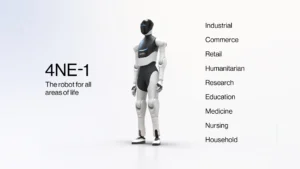
First of all, let me introduce you to the design. The appearance of a robot is crucial for its acceptance in our society. And here, form follows function. We have chosen a practical form to increase acceptance as we humans see ourselves reflected in it. We are not looking to create a fashion doll or a surrogate friend.
Here at NEURA Robotics, we believe research plays an essential role in the development of all of our cognitive robots, especially for 4NE-1. It is crucial to advance humanoid technology towards practical applications and fast forward the introduction of robots as everyday human helpers. That’s why we not only employ leading experts in the field of AI and beyond, but we also collaborate with a wide range of research institutions and work on projects which unite research and industry.
4NE-1 is more than a research study. 4NE-1 is a robust robot based on verified, cognitive Neura technology, plus an ingrained ability to fit perfectly into humanity’s everyday world.
Building on proven robotics technology
4NE-1 measures about 170 cm, weighs around 60 kg and can carry a considerable 20 kilograms. The combination of proven and novel Neura hardware enables it to perform all kinds of movements. 4NE-1 can walk forward and backward, turn, bend, and safely navigate different terrains and stairs while balancing delicate objects in its hands. In addition, 4NE-1’s head is an interactive screen for humans. While its primary function is to display status information and facilitate human interaction, it will also be fully customizable, allowing anyone to add a personal touch to their robot.
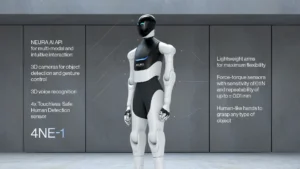
AI fans will be excited to know that 4NE-1 can recognize different human voices, languages, and even voice tones and emotions. 4NE-1 interacts with humans through voice and gesture control. Our AI API enables multi-modal and intuitive interaction between humans and robots, from voice commands in multiple languages to gesture control using the most natural tools we have: our hands and fingers. To achieve this, we use our fully integrated and complete AI cycle. It also enables other cognitive capabilities, such as object recognition and tracking.
Humans are the perfect all-rounder, which means a humanoid robot should have the same ability to handle all kinds of objects and perform tasks with extreme accuracy. This physical interaction with the environment is still one of the biggest shortcomings of current robots.
Our sensors provide full torque feedback in all moving joints, enabling 4NE-1 to detect the ground the robot is walking on and balance accordingly. Our market-leading force-torque sensors, with a sensitivity of 0.1 N and repeatability of up to ± 0.01 mm, enable 4NE-1 to balance itself as it walks and moves objects to a specific location quickly, smoothly, and most importantly – safely.
As far as human-robot interaction is concerned, we have created something fundamentally new, our unique and patent-pending Touchless Safe Human Detection technology. A sensor that can detect people and other moving objects even when the sensor’s view is obstructed by clothing, for example. To do this, we use AI to let 4NE-1 improve over time so that it can analyze a given situation and react accordingly. For example, by calculating and executing an alternative walking path, 4NE-1 can avoid a collision. This is what true collaboration between humans and machines means, not only in working industries but in all aspects of life.
The way ahead
Today, we as a society face a multitude of major trials. I am confident that with cutting-edge technologies such as cognitive robotics, we will be able to tackle many of our long-term challenges, as long as we tackle them head-on now.
That is what we are doing at NEURA Robotics. We design and build robots that not only help industrial companies to succeed but also enable everyone to spend more time doing what they love to do.
We are developing the ultimate helper robot.
A robot that supports any kind of task.
In the service of humanity.
For you.

